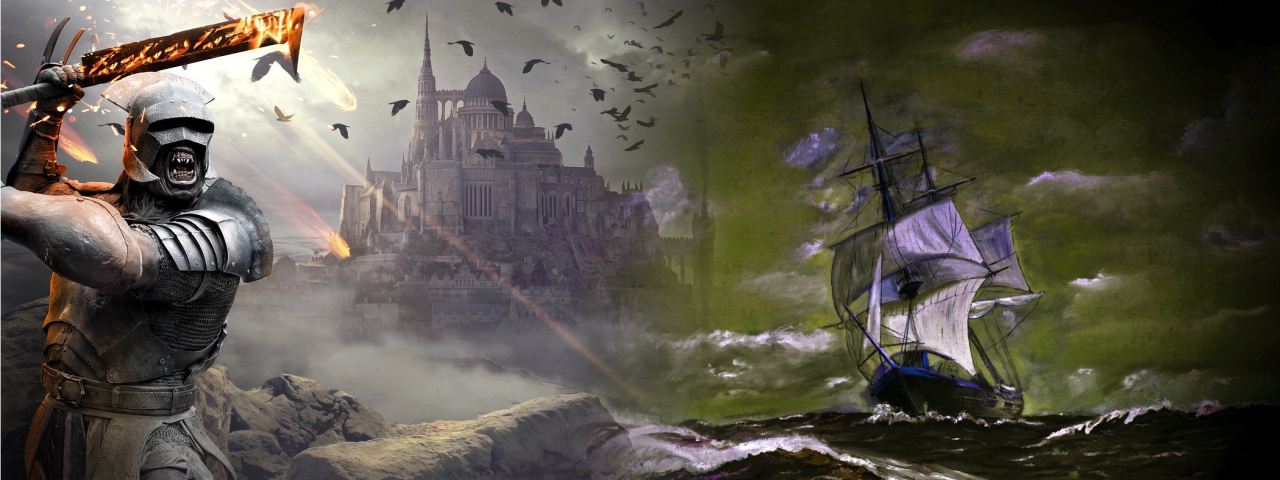The Pirate's Menu
Challenges of the Sea
It is not unusual for ships to spend weeks or even months in the deep sea. They must plan carefully, ensuring they can either carry or acquire enough rations and fresh water to keep their crews alive and healthy - and they must do so in the most space-efficient manner possible. Furthermore, they must deal with the inevitable fact that at sea, everything is damp! Mold and rot are real threats to stores that are not properly prepared or protected.Over the years, different cultures of the Folk have devised different solutions to the problem of feeding a crew on a long voyage. Today, thanks to inevitable sharing, the recipes contributed by one race of the Folk are often shared by all. The most popular include the following:
Human Hardtack
The most basic of all the food staples, humans started making hardtack out of wheat flour and a bit of water and salt since Saint Ancelin of Highhill first showed them how. The dry, cracker-like product that results from baking the simple mixture will last a very long time if it is kept free of condensation and mold. Packing it in barrels of salt is the best means of doing so, and few ships today sail without at least one keg of salted hardtack aboard.If fresher ingredients and ample water is around, the hardtack can be broken up and added as a sort of dumpling to a stew. Alternatively, it can simply be gnawed on for minimal sustenance.
Chittiki Rum-meal
The ratfolk make use of another common preservative to protect their seafaring food: alcohol. Whole grain seeds are mixed with animal fat and rum to create a pliable cake which is then wrapped in leaves or skins for storage. Usually, some dried fruits are added to the mixture as well - sun-dried berries, grapes, and figs being the most common choices. The cakes are typically made in "single serving" sizes for ease of distribution aboard ship.Some sea captains belive that the rum-meal cakes have the added advantage of including the sailor's daily ration of grog right along with their meals. A few - and not just Chittiki captains - will ensure an ample supply of rum-meal and forego kegs of rum entirely. They claim discipline is easier to maintain aboard ship.
Dwarven Sea-Bacon
Dwarven Bacon is one of the most popular preserved meats on all of Cartyrion, but when people think of this delicacy, they aren't thinking of the Seafarer version. Sea-bacon is simply salted and dried whitefish filets, usually packed in kegs of even more salt for storage and transport.Dwarves, who are notorious for their love of excessivly salty food, have been known to chew on chunks of the fish-based sea-bacon as if it were jerky. Most other folk find that it must be soaked in fresh water to remove some of the salt; the result is suitable for a fish stew, but not much else. Thus, unless the crew - or at least the captain - of a ship is a Seafarer Dwarf, sea-bacon is most likely not going to be among the food stores on board.
Felisean Biscuits
Feliseans like meat, and the fresher the meat, the better. Unfortunately, fresh meat doesn't last long before spoiling at sea. Thus, the catfolk have devised a method of shredding fresh meat into paper-thin sheets, then drying and flaking these sheets before adding them to a mixture of flour, whole grain, and fat. The resulting product is baked in large sheets before being broken up into pebble-sized chunks. The result is a meat/grain/fat combination that can be eaten quickly and easily.Many sailors will even keep some of their ration in a pouch and pop a few morsels into their mouths when the opportunity arises during their work on deck. On some occasions, The morsels can even be moistened and softened with hot water or perhaps a fish broth made from the bones of fresh catches.
Goblin Chilis
The other entries on this "menu" are all either grain or meat-based. It is the Goblins that bring a vegetative entry to the menu. If there is one thing about Goblin cuisine that is well known, it is the fact that Goblins love spicy hot foods. To this end, they have cultivated pepper plants to satisfy their craving for heat, resulting in the development of chili peppers which, when dried, are said to be so hot that they burn away mold and moisture. This may be true since, once dried, they do not need to be packed in any sort of dessicant or preservative; they are merely tied together and hung in bundles.Goblin sailors have no qualms about chewing on whole dried peppers. Most other Folk prefer to use the peppers - sparingly - as seasoning in fish stews. They are commonly added to the stews prepared with Dwarven sea-bacon to mask the otherwise unpalatable taste of the fish meat.
Halfling Honeytack
The Halflings were taught the same lessons as the Humans when it came to growing, harvesting, and preparing food, but the Halfling desire for food that is comforting as well as utilitarian led them to make some "improvements" on the hardtack that their taller cousins developed. Halflings discovered that by adding significant amounts of honey to the mix before baking, the result was a softer product that actually had an even longer shelf life. The honey itself acted as preservative as well as sweetener.Honeytack is not suitable for use as a dumpling additive to stews, though, so for most ships plying the waters of Cartyrion today, honeytack has not replaced hardtack. It is often carried as a supplement though, and some captains use it as a crew reward for special occasions.






This is awesome, Bob. I love how I learn a little bit about each species through what they eat at sea. It feels like you've really put some thought into each of these, and had some fun with it!
And I even got a Dwarven Bacon reference in there! Thanks for taking the time to read and comment.
The Perseus Arm - A new, alternative setting for fans of Traveller in any of its variations.
Laurels & Loot is a new, lightweight TTRPG rules system that hearkens back to the early days.